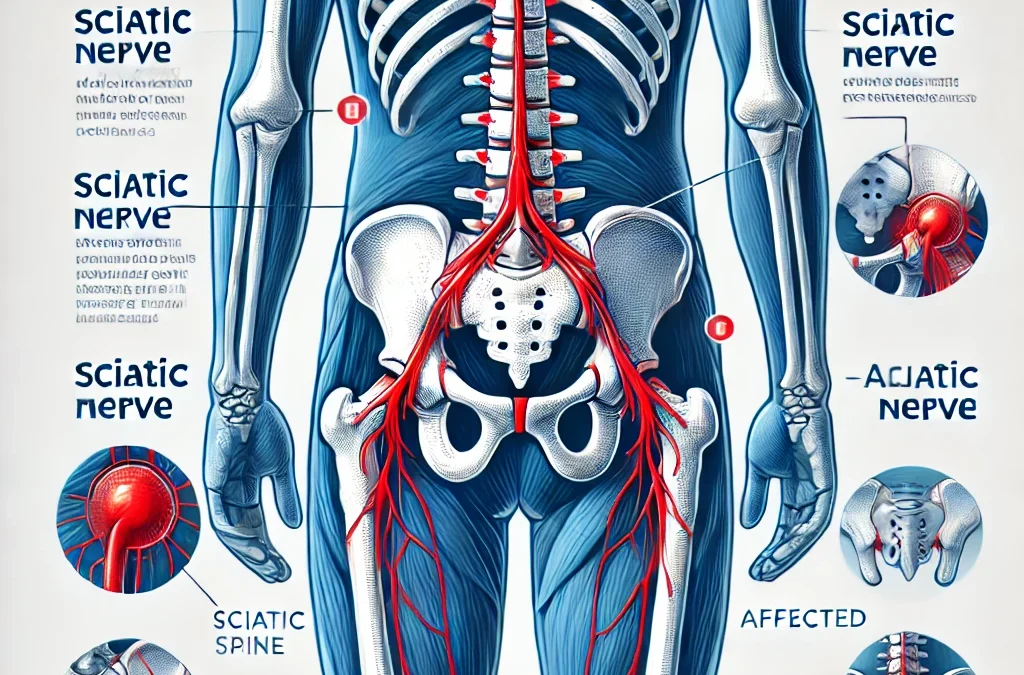Sciatica Demystified: Comprehensive Guide to Symptoms, Causes, Treatments, and Relief Stretches
Understanding Sciatica
Sciatica is a common condition characterized by pain that radiates along the sciatic nerve, which runs from the lower back through the hips, buttocks, and down each leg. It is not a diagnosis in itself but a symptom of underlying issues affecting the nerve. With proper understanding and management, most people can find relief and prevent recurring episodes.
Symptoms of Sciatica
Sciatica symptoms vary in severity and location, but the hallmark signs include:
- Pain: Sharp, burning, or shooting pain originating in the lower back, often radiating down one leg.
- Numbness or Tingling: Sensations of “pins and needles” in the leg or foot.
- Weakness: Difficulty moving the affected leg or foot.
- Worsened Pain: Symptoms may intensify with prolonged sitting, standing, or sudden movements like coughing or sneezing.
Common Causes of Sciatica
Sciatica arises when the sciatic nerve is compressed or irritated. Common causes include:
- Herniated or Bulging Disc: The most frequent cause, where the disc presses on the nerve.
- Spinal Stenosis: Narrowing of the spinal canal compressing the nerve roots.
- Piriformis Syndrome: Spasm or tightness of the piriformis muscle irritating the nerve.
- Spondylolisthesis: A vertebra slipping out of alignment, pinching the nerve.
- Injury or Trauma: Accidents affecting the lower back or pelvis.
Diagnosing Sciatica
- Medical History and Physical Exam: Your doctor will assess symptoms, reflexes, and strength.
- Imaging Tests:
- MRI: Provides detailed images of nerve compression.
- X-rays: Reveal alignment issues or bone spurs.
- CT Scan: Useful for diagnosing stenosis or other structural problems.
Treatment Options
1. At-Home Remedies
- Rest: Avoid activities that worsen symptoms but keep light movement.
- Cold and Heat Therapy: Use cold packs for inflammation and heat for muscle relaxation.
- Over-the-Counter Pain Relievers: NSAIDs like ibuprofen can reduce pain and swelling.
2. Physical Therapy
A physical therapist can design a program to:
- Strengthen core muscles.
- Improve posture and flexibility.
- Reduce pressure on the sciatic nerve.
3. Medical Interventions
- Prescription Medications: Muscle relaxants or stronger pain relievers.
- Epidural Steroid Injections: Reduce inflammation around the nerve.
- Surgery: For severe, persistent cases, such as a microdiscectomy to relieve nerve pressure.
Additional Stretches for Relief
Regular stretching can alleviate tension on the sciatic nerve. Include these in your routine:
- Piriformis Stretch:
- Lie on your back with knees bent.
- Cross one ankle over the opposite thigh.
- Pull the uncrossed thigh toward your chest.
- Seated Spinal Twist:
- Sit with one leg extended and the other crossed over it.
- Twist your torso toward the bent leg, placing the opposite elbow outside the knee.
- Child’s Pose:
- Kneel and stretch your arms forward, lowering your hips toward your heels.
- Hamstring Stretch:
- Sit on the floor with one leg extended and the other bent.
- Reach toward your toes, keeping the back straight.
- Knee-to-Chest Stretch:
- Lie on your back and pull one knee toward your chest.
- Hold for 20 seconds and switch legs.
- Cobra Pose:
- Lie face down and push your upper body up with your arms while keeping hips on the floor.
Preventing Sciatica
- Exercise Regularly: Focus on core strength and flexibility.
- Maintain Good Posture: Use ergonomic chairs and avoid slouching.
- Lift Properly: Use your legs, not your back, to lift heavy objects.
- Healthy Weight: Reduce strain on your spine by maintaining a healthy weight.
Resources for Further Support
- Professional Organizations:
- Support Groups:
- Sciatica Support on HealthUnlocked (healthunlocked.com)
- Apps:
- “StretchIt” for guided stretching routines.
- “Curable” for chronic pain management.
- Books:
- “Healing Back Pain” by Dr. John Sarno
- “Back Mechanic” by Dr. Stuart McGill
- Specialists:
- Chiropractors, physical therapists, and orthopedic surgeons.
When to Seek Immediate Help
- Loss of bladder or bowel control.
- Severe or worsening pain despite treatment.
- Numbness spreading to both legs.
Final Thoughts
Sciatica can significantly impact your quality of life, but with a combination of self-care, medical treatment, and preventative strategies, you can manage and reduce symptoms effectively. Consult a healthcare provider for a tailored approach to your condition and make proactive lifestyle adjustments to maintain spinal health.





Recent Comments